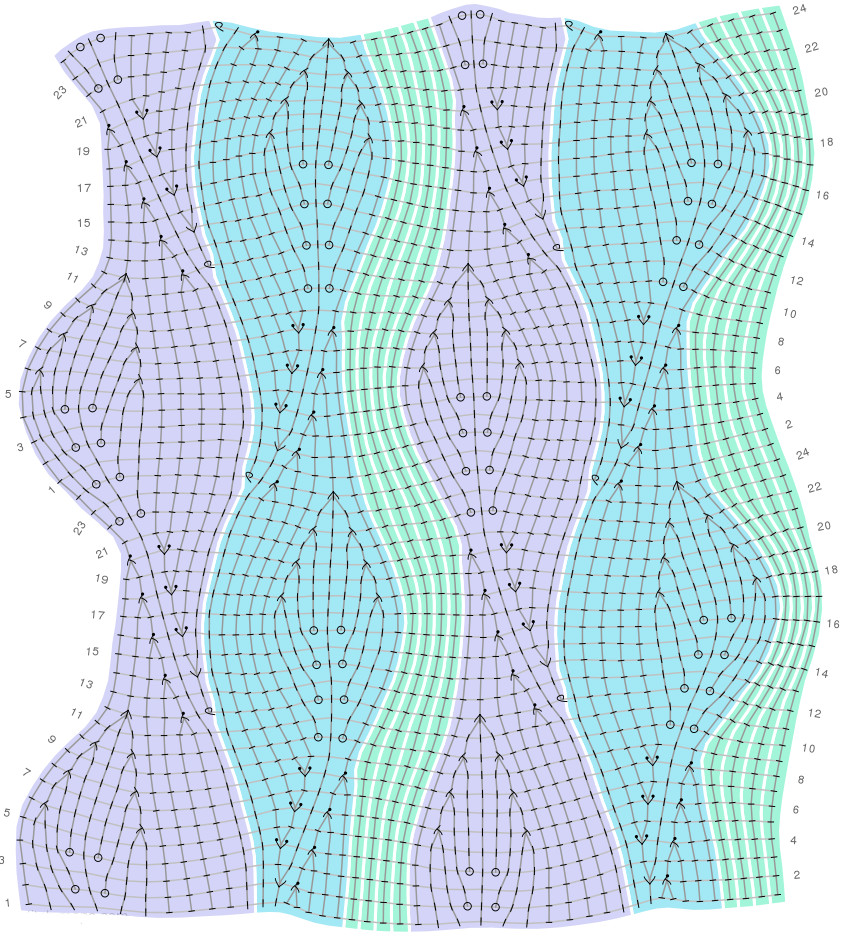Stylish modern models, crocheted, are becoming increasingly popular today, and have already taken their place in the latest fashion shows of the world catwalks. The relevance of the models is ensured by the latest types of yarn and unusual techniques. Among the latter, a technique called “Swing” is gaining momentum.
What kind of technique is this?
This is a technique for knitting asymmetrical patterns with knitting needles or a crochet hook, which uses shortened rows. In the material below, you will find information about what kind of knitting style this is, get acquainted with the principles of creating products using the Swing technique and with a description of the instructions for making several models.
History of appearance
This handicraft technique, which is suitable for both crochet and knitting, borrowed its name from music.

The word "Swing" in the English-speaking environment is used to denote oscillatory movements - rocking, swaying, oscillation. This term entered the musical world with the emergence and development of jazz.
One of the styles of this musical direction – swing – is characterized by a rhythm similar to oscillations with symmetrical “rise” and “decay” of the melody.
From music, the term migrated to dance culture, now being linked to movements and giving the same name to a dance that is captivating in its dynamics and has become extremely popular among people of almost all ages.
Short rows have been used in the knitting world for a long time. Such rows allow you to create more or less smooth lines.
In knitted items, edges with greater or lesser curvature are used to form armholes, necklines, sprouts, caps, hemlines of dresses or bottoms of sweaters, reliefs. And one day, one of the needlewomen decided to connect such areas with curved edges together, getting a whole piece of fabric.
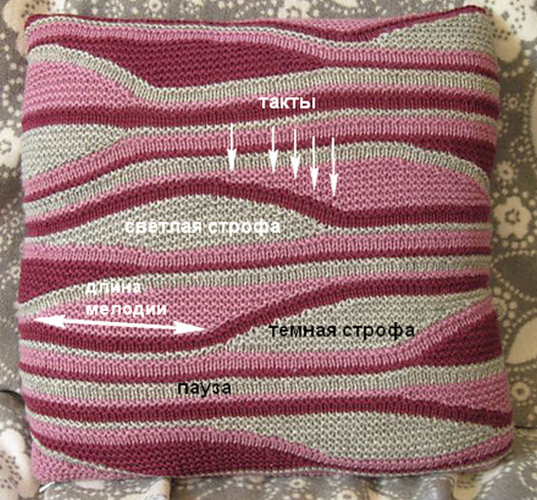
Then, through trial and error, the craftswomen combined such fragments, obtaining different shapes, putting together sections with shortened rows like puzzles into a single product. Often, the fragments were made from yarn of different types and colors, and when combined, they formed something like a patchwork quilt.
Over time, creative reworking of the technique led to the fragments taking on certain shapes: a triangle, a petal or oval, a trapezoid.
When knitting such fragments, they began to observe a certain "rhythm" that determined the lengthening or shortening of a row. The fragment itself, repeated in a particular product, was called a "melody", and completely knitted rows (lines without additions or decreases) - "stanzas".

The Swing Crochet technique, with its peculiar "oscillation" as you crochet back and forth through a series of shortening or lengthening rows, is reminiscent of the swaying movements of a swing dance or a jazz melody. Hence the characteristic terminology taken from the world of music and dance.
Basics of crochet technique
The Swing technique is no less exciting when working with a crochet hook than when working with knitting needles. This method is based, as already mentioned above, on partial knitting techniques or, in other words, knitting using shortened rows. Smooth curves or stepped lines give expressiveness to the pattern.
The nature of the lines will depend on the pattern and the author's idea. For example, connecting columns and half columns make it possible to create a smooth border line between fragments of the canvas, and columns with one or more yarns are convenient for highlighting clear geometric lines, like steps.
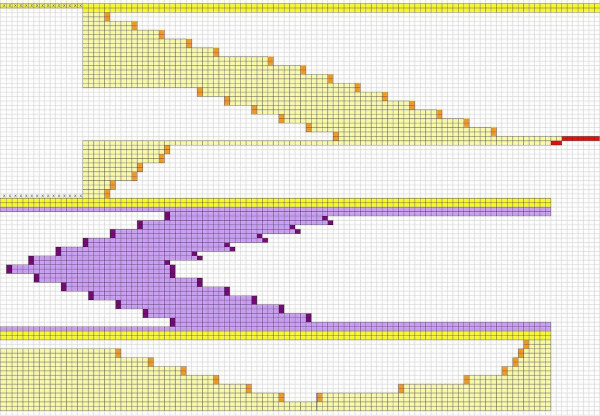
Advantages of the short row technique:
- Beautiful contours of the product and the ability to achieve a perfect fit.
- The ability to create a pattern on a canvas using only a few basic elements – columns, double crochets.
- The ability to create a “picture” using yarn of different colors to knit different fragments.
The Swing crochet technique is suitable for knitting:
- hats and panamas,
- scarves and stoles,
- tops, vests,
- blankets, covers for decorative pillows,
- wall panels.
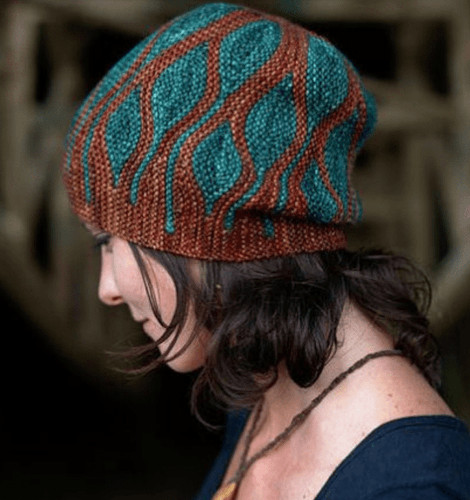
Swing technique techniques are used by:
- When knitting patterns with complex geometric shapes.
- To imitate a patchwork product.
- When forming darts,
The Swing crochet technique is accessible even to those who are at the initial stage of studying this type of needlework and have mastered only its basic techniques.
It is enough to know how to knit a chain, slip stitches, half stitches and single crochets to master the basics of the Swing technique and create a beautiful wardrobe item - an accessory in the form of a scarf or even a top.
Over time, as your skill grows, you can make this technique more complex by adding openwork patterns to the lines.
The distinctive features of the Swing technique are as follows:
- The fabric of the product consists of fragments with different directions of lines and patterns.
- The fragments can be made from yarn of different colors and .
Swing Crochet Patterns
| Operation | Scheme | Description |
| Smooth transition to a row of double crochet stitches | 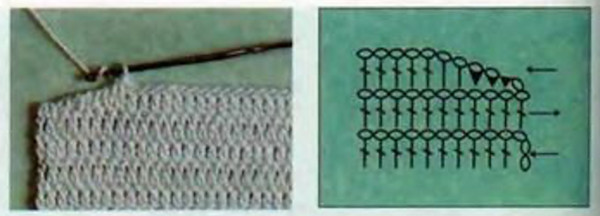 | 1 chain stitch, 1 slip stitch, 2 single crochets, 2 half double crochets, double crochets. |
| Smooth transition FROM a row of double crochets to the one below | 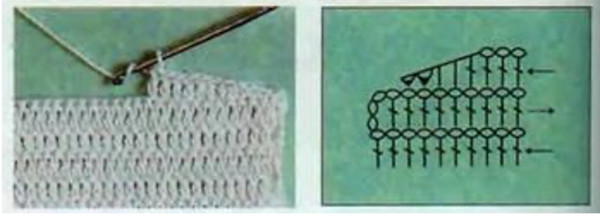 | 2 double crochets, 2 half double crochets, 2 single crochets. |
| Smoothing series |  | To align the edge, the next row after the shortened one is knitted over it, moving onto the one below. |
Light stanza
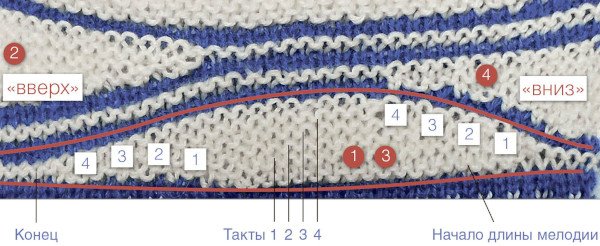
Dark Stanza
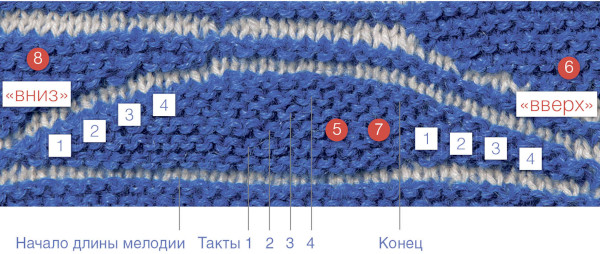
What to knit from leftover yarn
The more knitting practice you have, the more scraps of yarn of different colors, compositions, and thicknesses each needlewoman accumulates. Swing is one of the best techniques for using small amounts of yarn, which may not be enough even for a very small job - a napkin, short mittens, a toy.
The hook in this technique allows you to create a more "picturesque" product in terms of the pattern than knitting needles. A smooth transition line can be formed already in one row, due to the transition from the pattern or a column with yarns to half columns or connecting columns. This achieves a decrease in the height of the row.
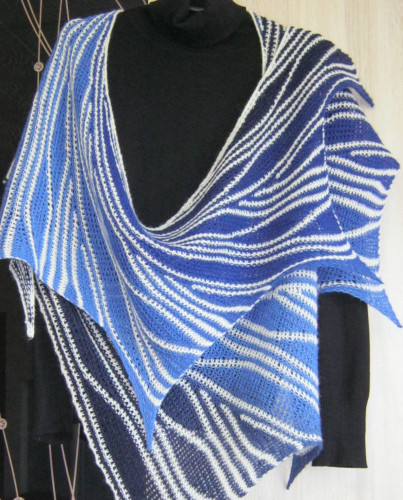
From the remaining yarn you can knit:
- Accessory: scarf or stole.
- The upper shoulder garment is a top or vest.
- Headwear - a Panama hat or a cap.
- Interior items – covers for decorative pillows, covers for bolsters against drafts, bedspreads.
The swing crochet technique is perfect for creating bright interior details.
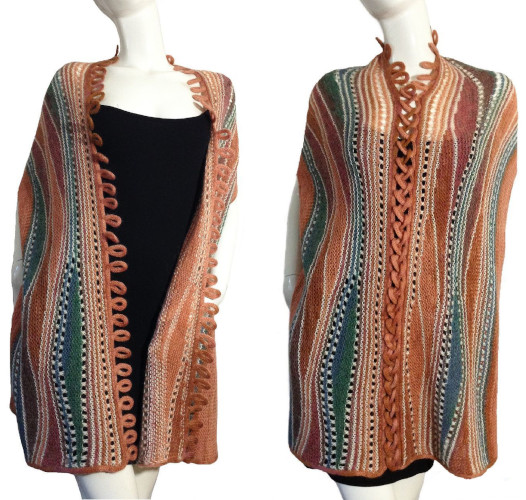
Beginners or those needlewomen who are just beginning to master this knitting method are best off trying it on simple-shaped items - rectangular covers or scarves. Such work will help you understand the logic of the style, achieve symmetry and empirically determine the combination of patterns and the method of forming smooth curved lines.
Swing Crochet Master Classes
This section provides a description of the simplest products knitted using the swing technique - a snood and a top or vest. The first model for beginners to crochet is the simplest, so beginners can be recommended to get acquainted with this method with a snood using regular single crochet stitches.
Having mastered it, it will not be difficult to complicate the process with rows, connected with more complex patterns - trefoils, flowers, and any other openwork elements. The second model is somewhat more complicated, but it differs only in a few points, which are explained in detail in the description.
Snood crocheted in swing technique
The simplest model to practice the Swing knitting technique and create a useful accessory for the cold season - a snood made of single crochets. You can use both winter wool (or blended with wool) yarn, and cotton yarn, suitable for knitting accessories for the off-season.

The hook should be selected according to the manufacturer's recommendations indicated on the label of the skein. If there is no tag, knit a small sample with single crochets and evaluate the density. If necessary, change the hook number to a larger or smaller one until you achieve a suitable option. We will describe the snood pattern step by step.
For example, let's take yarn with a length of 250 m/100 g and hook No. 3:
- 1st row: knit a chain of 50 air loops + 1 lifting air loop.
- 2nd row: knit 1 single crochet (SC) into each chain stitch of the previous row, knitting it to the end. That is, you need to knit 50 SC in total. At the end of the row, make 1 air loop (AL) for lifting.
- 3rd row: knit the first shortened row. To do this, knit 1 sc in each column of the previous row, not reaching 5 loops to the end. That is, you need to knit 45 sc in total. At the end - 1 lifting VP.
- 4th row: knit 45 sc, knitting them 1 in each column of the previous row. 1 lifting VP.
- 5th row: knit the next shortened row with the same rhythm - without knitting 5 loops to the end of the previous one. That is, now you need to knit 40 sc. 1 VP for lifting.
- 6th row: knit 40 sc, 1 in each loop of the previous row.
The result should be a stepped line of smooth bevel. You need to shorten the rows until there are 5 sc left in the last row. After that, knit a "smoothing" row with connecting posts or single crochets along all the loops along the slope. The last loop in each "step" is knitted into a lifting loop.
As a result, the resulting fragment takes the form of a triangular wedge. Since the snood is a rectangle sewn into a ring (pipe), then another wedge must be added to the resulting wedge, the bevel line of which will coincide with the bevel line of the first wedge. To knit the second fragment, repeat the previous steps in reverse order.
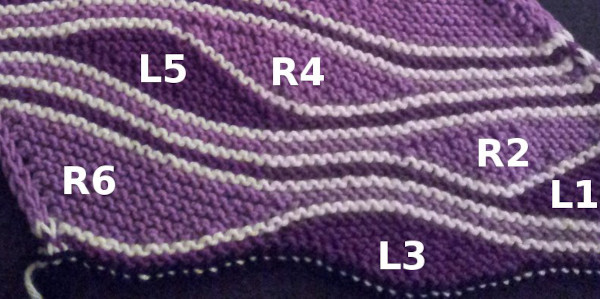
That is, the scheme of this part of the work will be as follows:
- Knit 5 sc 1 at a time into the first 5 loops of the previous “smoothing” row. 1 air loop for lifting (ALL).
- Return in the opposite direction, also knitting 5 sc. 1 VP.
- Knit 1 sc in each loop of the previous row (5 sc) + 5 sc, 1 in the loops of the “smoothing” row. A total of 10 sc. 1 VP.
- Return in the opposite direction, now knitting 10 sc. 1 VP.
These steps (increasing 5 sc in every second row) are repeated until the length of the row is 50 loops, as was originally cast on. Alternating these fragments, knit a rectangle of the required length.
The length is chosen based on how many turns the snood needs, 1 or 2. For example, for an adult size, you need to knit a piece of fabric 50 to 60 cm long. The number of fragments should be even, since every second section aligns the bevel line that is obtained when knitting the first.
Finishing the work is joining the first row with the last. You can sew the fabric to the pipe with a crochet chain stitch. If desired, the longitudinal edges can be tied with any border.
For each fragment, you can take yarn of a different color, shade, add a thin thread of lurex, mohair. You can use sectional dyeing yarn. The scope for imagination when working with a crochet hook in the swing technique is endless.
Crochet top in swing technique
For the top (vest) you will need thin yarn with a yardage of 400-420 m per 100 g and a hook 3.5-3.75. The product is knitted from 2 identical pieces - front and back.
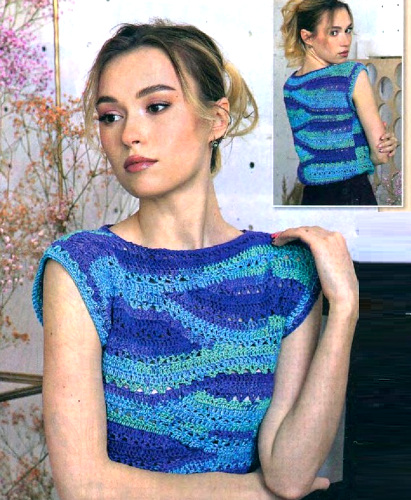
- Cast on a chain of air loops equal to half the chest volume with the desired allowance for ease of fit. Since the rapport of one of the patterns is 8 loops, the resulting number of loops should be a multiple of 8 + 1 loop. Add or subtract if necessary. Comment: Please note that after WTO the product will change its dimensions depending on the properties of the yarn, so you must first knit a sample with single crochet stitches and measure its dimensions before and after WTO.
- In the initial row, from each loop of the row below, knit one dc.
- In the next (2nd) row, the pattern will be as follows: 1 VP, 1 SC, H. 3 loops of the row below are skipped and from the 4th, 3 lush columns are knitted, making a connection between them from 2 VP. Lush columns, depending on the yarn, can be knitted from a different number of yarns: 3, 4, 5. The next trefoils are knitted according to the same pattern, again skipping 3 loops of the row below.
- In the third row, knit 3 lifting loops, *3 VP, in the central column above the flower motif, knit SC*. Repeat between * to the end of the row.
- The 4th row begins with a VP. Next, knit connecting posts over two flower motifs and the next post before the third motif. Under the next arch, knit 3 SC and 1 SC in the post of the previous row. Under all the following arches and posts between them - 3 SN and SN until the end of the row. At the end of the row - 1 SC in the third VP.
- 5th row: dc, without knitting 4 motifs to the end of the row. In the loops above the next arch and in the loop of the column between the arches, knit half columns. The next arch and the column after it - 4 sc. Finish knitting this shortened row with a slip stitch.
- Row 6 begins with slip stitches (SS) to the dc of the previous row. 1 sc. Next, over the trefoils of the 2nd row, crochet trefoils to the end of the current row.
- Repeat step 4 to the middle of the last motif of the previous row. Repeat steps 5-8 one more time and the first fragment is ready. After it, knit a smoothing row with double crochet stitches.
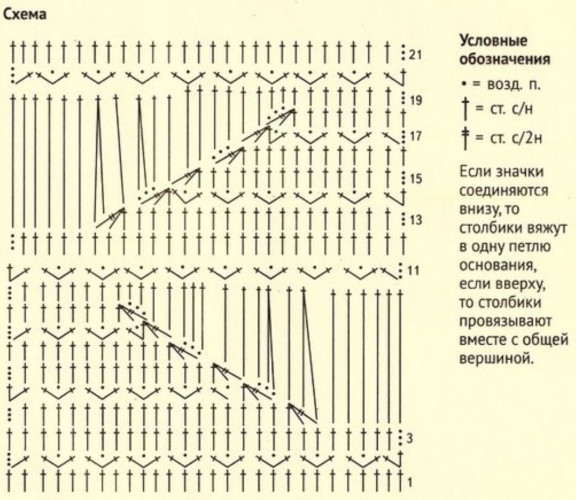
The 2nd fragment is knitted according to the same pattern, but increasing the length of the rows, aligning the fabric. Both fragments are repeated until the desired length of the product. To knit the shoulders, another 1st fragment is symmetrically performed, starting from its middle. The back is knitted similarly. The parts are sewn with a chain stitch along the side and shoulder cuts.
Knitting socks in swing technique
Knitting socks using the swing technique is shown in the photo with a description.
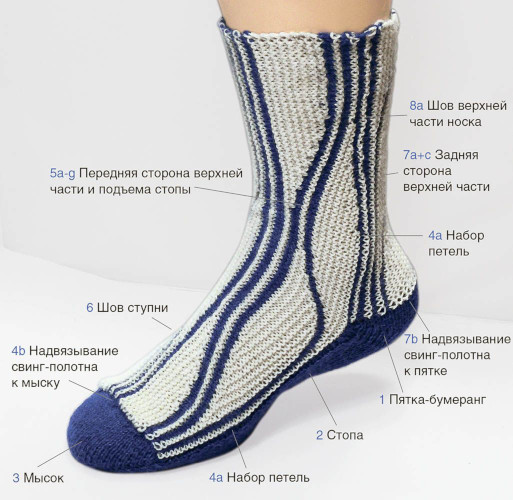
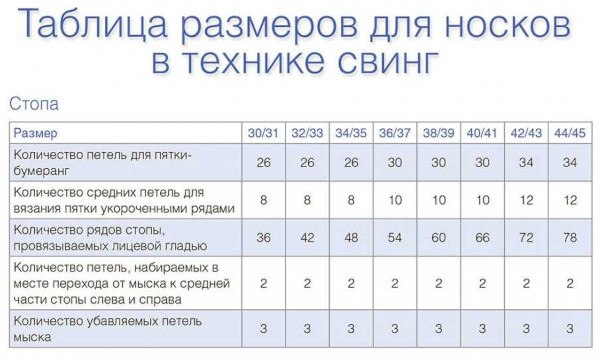
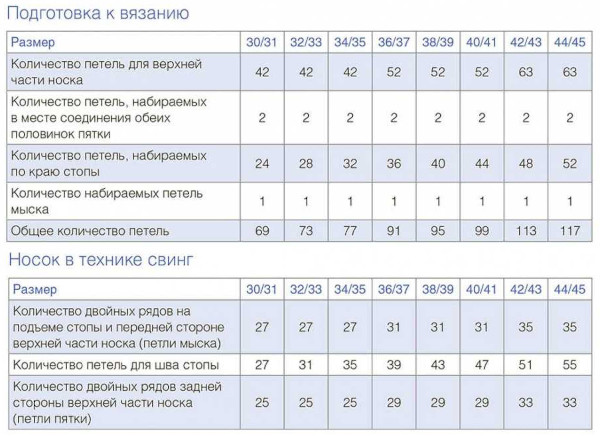
Advice from experienced craftsmen
In this section we will give general recommendations to ensure that the product turns out beautiful and does not evoke associations with a patchwork quilt, which looks best in its rightful place.
Experienced craftsmen recommend taking the following points into account:
- The hook number should be selected according to the thickness of the thread. But you can deviate a little from the recommendations of the yarn manufacturer if you want to make the product softer, airier or more delicate and the pattern allows it. Then select a hook of a larger number, checking the quality of the work on a sample. High density is suitable for bags knitted in this style.
- Shortened rows of fragments of one color can be made without breaking the thread. To do this, the last loop of the row is closed, and the thread, without breaking, is pulled over the "braid" of the previous row. In the first row, which will be knitted from this "braid", the loops of the lower row captured by the hook, together with the thread lying freely on top of them, will disappear in the new loops.
- It is advisable to make a color combination taking into account their compatibility and contrast. You can, if desired, take into account fashion trends if they do not contradict your taste. And it is necessary to take into account your (or the person for whom the wardrobe item is knitted) color type of appearance.
- If the product is made in one color or from melange yarn, then to give the fragments from shortened rows more expressiveness, at least one row should be made with a contrasting pattern. For example, if the main pattern is columns (connecting, half columns, single crochets, with 1, 2 yarns), then any of the rows can be knitted with an openwork pattern. For an openwork strip, you can use any border pattern: flowers, leaves, etc.
- To give the product a modern look, use the shades that are relevant for the current season and their competent combination with neutral colors.
- To choose the right colors, it is worth spending some time studying the color wheel. This will enhance the aesthetics of your products and draw attention to such things.
Advice from experienced needlewomen will help make the product as high-quality and aesthetic as possible. A beautiful appearance combined with impeccably executed knitting techniques will make the item exclusive. Items crocheted using the swing technique are very attractive due to their unusual patterns and designs.
Even a single-color item, in which instead of strict straight lines or a rhythmically repeating pattern there is asymmetry and a hint of chaos, looks more refined. Swing-knitting items are most often knitted in a single copy, and the image of their owner in such an outfit will certainly be refined and unique.
Video about Swing-knitting
Knitting wedges using the Swing crochet technique:

